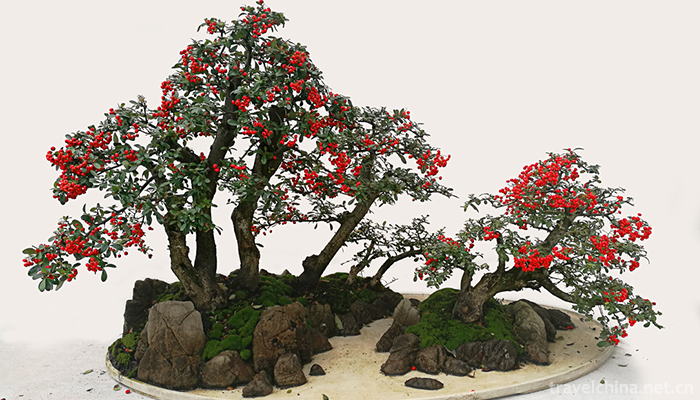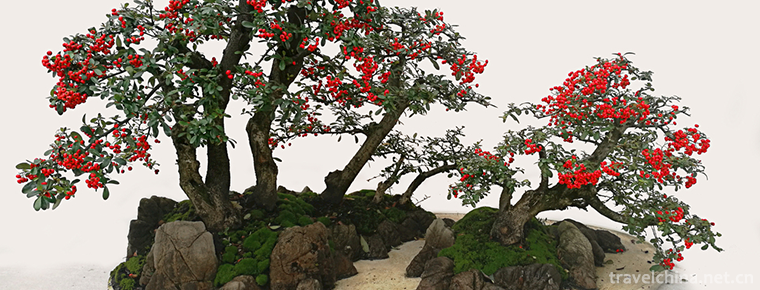The technical skill of penjing
The technical skill of penjing
Bonsai art refers to the Soviet bonsai art, which originated in the Tang Dynasty, flourished in the Ming Dynasty, matured in the Qing Dynasty, and developed in modern times. Since the 1980s, Suzhou Bonsai has won many awards in exhibitions at home and abroad.
Bonsai is one of the traditional Chinese arts with a long history. Bonsai production often takes several years or decades to create. It is undoubtedly the desire of bonsai enthusiasts and producers to create a good-looking wound in a relatively short time.
In 2011, it was selected as the third batch of national intangible cultural heritage list.
Historical Origin
Bonsai art refers to the Soviet bonsai art, which originated in the Tang Dynasty, flourished in the Ming Dynasty, matured in the Qing Dynasty, and developed in modern times. Since the 1980s, Suzhou Bonsai has won many awards in exhibitions at home and abroad.
Bonsai is a combination of planting plants in a vessel, decorating mountains and rocks, etc., to show a kind of artistic conception of nature, and to see the changes of the four seasons.
Skill Tips
Branches are straight and curved.
Sparse places can walk horses, close places can not be ventilated.
One branch sees twists and turns, two branches are long or short, three branches are scattered, many branches are exposed and hidden.
The straight position should be hidden but not exposed, and the straight position should be exposed and not hidden.
Plum-blossom bonsai would rather bend than straighten.
Bonsai is a silent poem, three-dimensional painting and living sculpture.
On the day of Jingcheng, the achievements will last for ten years! ___________
If you are not afraid of cutting wrong branches, you are afraid of standing in wrong places.
Store up skills and cut off dryness. Zhangshan, Chishu, inch horse, divide people. There are no trees in the distant mountains.
Creation is a wonderful painter, and the terrain is very close to the sky.
Jiaolong has 30,000 hectares and 12 peaks in rain and cloud.
Seats make people vulgar, leisure to act as a fresh breeze.
Drunken Dream in the Leaf of the River and Lake
Go strong and leave weak; go coarse and leave thin.
The trial should be accurate and the verdict should be ruthless.
Rugao bonsai, looking left and right at two and a half bends, clouds, rain feet, beauty waist.
If you don't pour it, it will penetrate.
Dry and wet, thin fertilizer and diligent application;
Scenic trees have no roots, like cutting wooden pavilions at the top, potted landscape feet.
Spring wiping ectopic buds,
Cut strong and weak branches in summer.
In autumn, topdressing should be done.
Cut the branches in winter.
Note: This is a part of Potted Landscape Skills Tips. See Resources for more information
Inheritance Significance
After thousands of years of inheritance, Chinese bonsai art has experienced many natural disasters and social turbulence, and has finally become an important part of Chinese and Eastern culture. Further implement the working principle of "protection first, rescue first, rational utilization, inheritance and development", conscientiously do a good job in the protection and management of intangible cultural heritage, and make new contributions to the promotion of Chinese culture and the great development and prosperity of socialist culture.


-
1.Jiang Cudan Canton style pig leg
Except for those with internal fever, dry stool and weak spleen and stomach function, breast enlargement products can be used as a warm-up tonic in winter.
Time 2018-11-02 -
2.The Siberian Tiger Park
Located on the North Bank of Songhua River, the Northeast Tiger Forest Park covers an area of 1.44 million square meters and is adjacent to the Sun Island Scenic Area. Among them
Time 2018-12-19 -
3.Baligou Scenic Area
Baligou Scenic Area is located in the deep mountain area of Shangbali Town, Huixian County, Xinxiang City, Henan Province, 50 kilometers northwest of Xinxiang City, the southern foot of Taihang Mounta
Time 2018-12-24 -
4.Jianglangshan 28du Tourist Area
28du Town, located in Jiangshan, Zhejiang Province, is a famous historical and cultural town. It is a writer's creation base in Zhejiang Province. It is located at the junction of Zhejiang,
Time 2019-01-21 -
5.Zhoucun Ancient Mall
Zhoucun Ancient Mall, also known as Street, is located in Zhoucun District, Zibo City, Shandong Province. The main road of Shandong Province, Jiqing Expressway
Time 2019-03-20 -
6.Acrobatics in Dongbeizhuang
Dongbeizhuang acrobatics is a traditional folk acrobatics in Puyang City. Dongbeizhuang, Yuecun Township in Puyang City, is a pearl in the vast plain of northern Henan Province
Time 2019-04-27 -
7.Wuyin Opera
Wuyin opera has a history of nearly 300 years. Its singing style is graceful and charming. It is known as "Northern Yue Opera". Its occurrence, development and finalization have gone through
Time 2019-06-29 -
8.Anhui University of Finance and Economics
As a multi-disciplinary finance and economics university, economics, management and law are the first batch of universities that have the right to grant bachelor's degree and the third batch of granti
Time 2019-09-30 -
9.Fried meat with chili
Stir fried meat with chili is a dish made with chili and streaky pork as the main ingredients and soybeans, garlic seeds, soy sauce, oil salt, monosodium glutamate and ginger as auxiliary ingredients.
Time 2020-03-18 -
10.Evolution of Chengdu Giant Panda Base
Chengdu Giant Panda Breeding Research Base is established on the basis of raising, treating and breeding giant pandas in Chengdu Zoo. In the 1980s, Fargesia FRIGIDA in Qionglai mountains blossomed and died. Some giant pandas were rescued and concentrated in Chengdu Zoo for lack of food and hunger.
Time 2020-12-13 -
11.Administrative division of Nanchong
Nanchong City governs nine county-level administrative divisions (Municipal District 3, county-level city 1, county-level 5), and 241 township level administrative divisions (street 42, town 161, township 38). It covers an area of 12514 square kilometers and has a population
Time 2020-12-17 -
12.Dazhou folk culture
Dazhou yuanjiu Climbing Festival this tradition has been followed for thousands of years, every year on the ninth day of the first month, hundreds of thousands of people travel to the city, this spectacular scene is also rare in the country. It is said that i
Time 2020-12-20